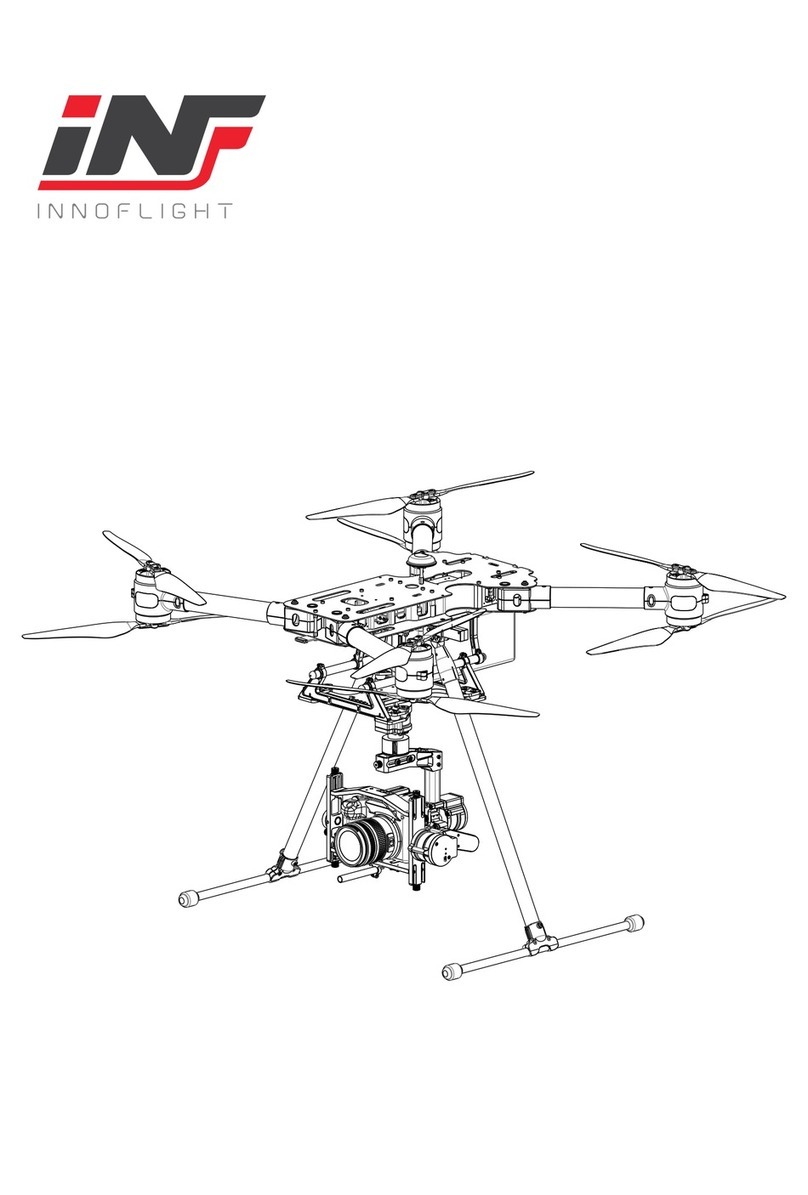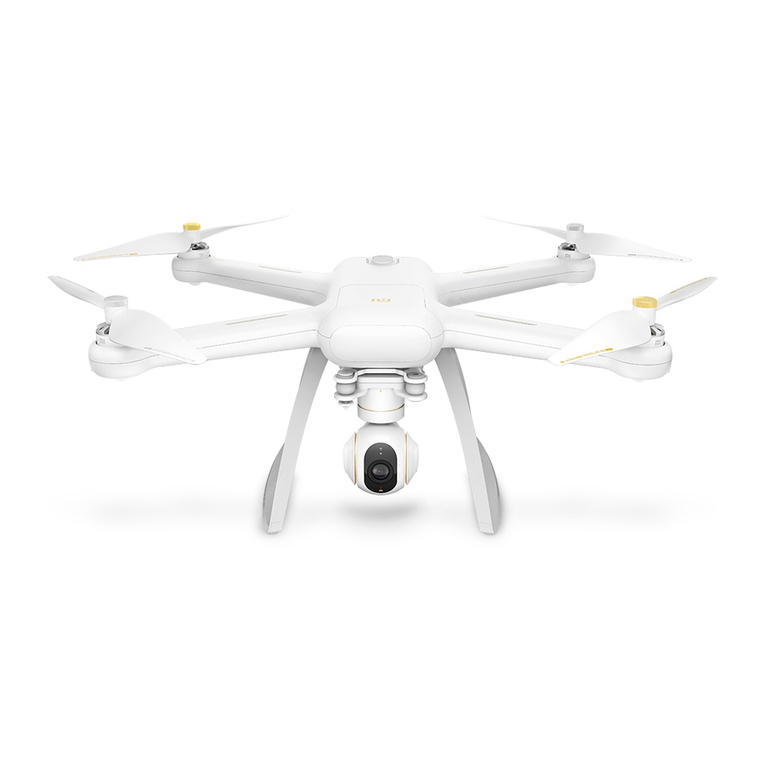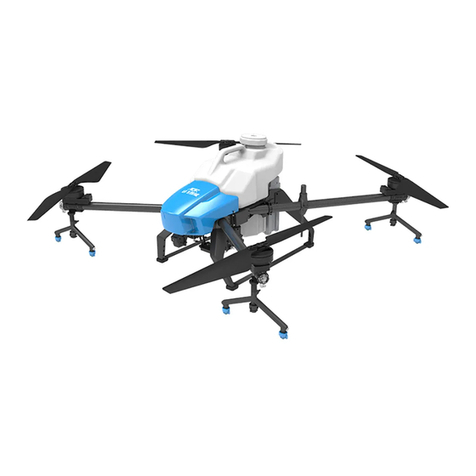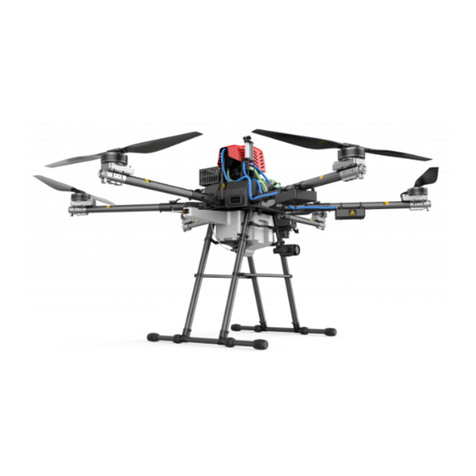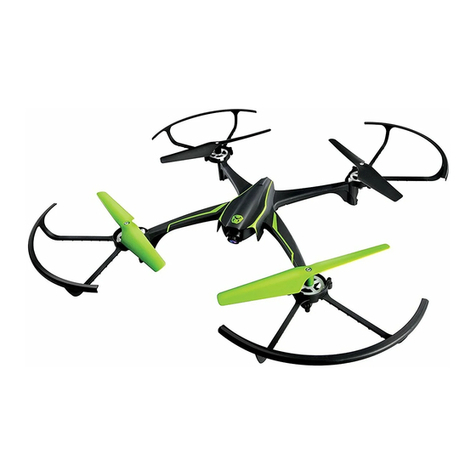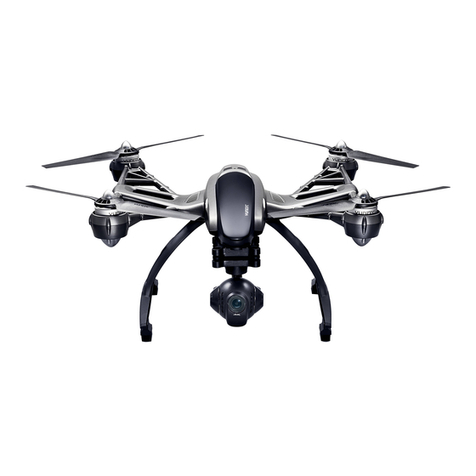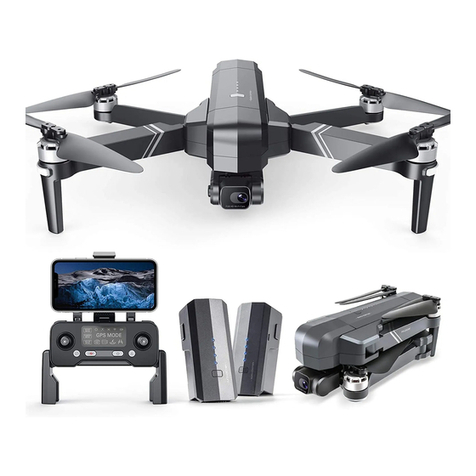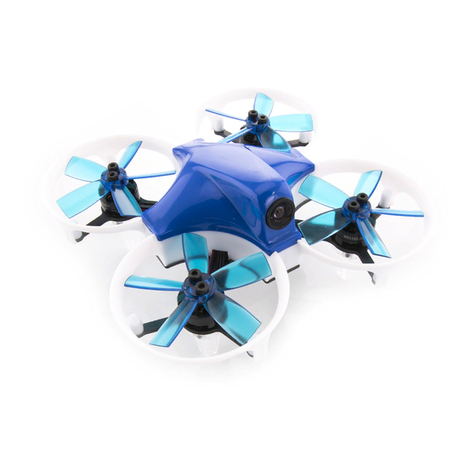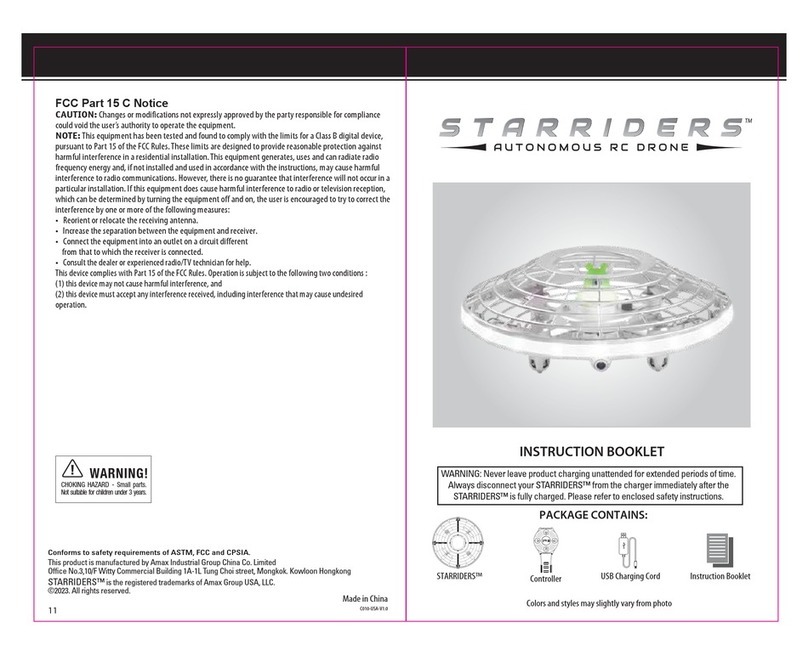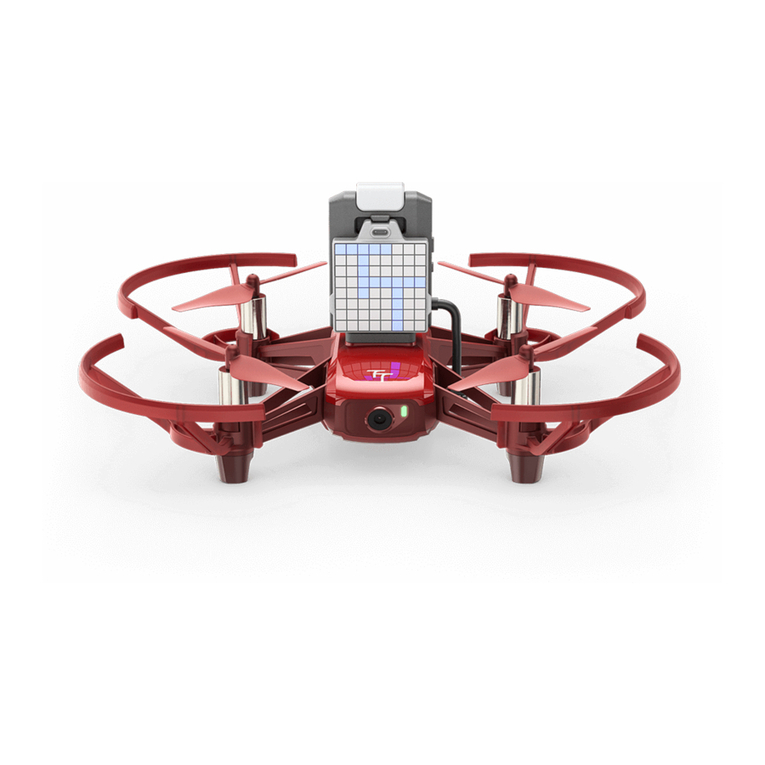Speedwolf SP-Basic20 User manual

For SP-Basic20
Unmanned rotorcraft User Manual

CONTENT
Disclaimer
II. Before Flying (Preparations for Flying)
III.Taking off
I.Flying warnings
IV. Landing and Locking Motors
V. Possible Malfunctions and Solutions
Diagrams of Flying Operations
5
5
1
5
6
6
3
3
3
3
3
4
4
4
Transmitter Stick Operation
Unlock and start motors
Lock and stop motors
Basic self-calibration
Propeller Installation
Forward Direction of the Aircraft
LEDs and Low-Voltage Alert
2
Specifications & Parameters
4
Usage of Battery and Charger

Disclaimer
Thank you for purchasing Speedwolf—the stylistic multi-rotor aircraft. Please read the
following disclaimer carefully before flying to avoid any unexpected accident or damage.
We won’t accept any liability for the following damage(s) or injuries.
1.Damages or injuries caused by illegally flying in government regulated no-fly zones or other
dangerous areas.
2. Damages or injuries caused by mis-operation, mis-judgment or when the aircraft flies beyond the
users' sight.
3. Damages or injuries caused when users intentionally perform inappropriate operations.
4. Damages or injuries caused by malfunctions which result from users' refitting the aircraft at will.
5. Damages or injuries caused when users suffer from any abnormal conditions which could impair
the users' ability whether physically or mentally, and couldn't concentrate their attention on the
flying.
6. Damages or injuries caused by continued flying when the aircraft is in abnormal conditions due
to water, sand or other unknown materials entering the aircraft or due to obviously defective
components or parts or when the low voltage protection alarm has been triggered.
7. Damages or injuries caused when users don't stay away from crowds, obstruction, tall buildings
or other dangerous objects.
8. Damages or injuries caused when users fail to follow the guidance of the User Manual so that the
aircraft crashes because the single flight lasts so long that the battery runs out.
9. Damages or injuries caused when the aircraft flies in terrible weather, such as thunderstorm, fog,
strong wind, hail, lightning, tornadoes, hurricanes, in magnetic interference area. snow etc. or
10. Damages or injuries caused by the misuse of the battery or battery chargers or by using 3rd
party products, especially 3rd party battery chargers or fake Speedwolf products.
11. Other losses which are not covered by the scope of Speedwolf liability.
12. Speedwolf technonlogy co.,LTD reserves all the right for the final explanations.
This product is designed for adults (over 18years old)
Any user of this product is hereby deemed to have
accepted the disclaimer.
1

Specifications & Parameters
Size: 310X310X92MM
Arm length: 425MM
Motor: KV 935
Battery:11.1V
Flight Load: 1.3KG to 1.5KG
Flight Time: 15—30 minutes
Environment: indoor & outdoor
310mm
310mm
6
228mm
9mm
25.8mm
9 inch Propeller
Package size
Size:X360X100MM
Large battery compartment
Can be Placed two 3S
flight time:15-30minutes.
2
NOTE : Speedwolf SP-Basic20 can install
stainless steel wire Landing Gear and
G i m b a l f o r c a m e r a b u t s h o u l d b e
purchased separately
Installation
2200MAH/2800MAH
/5600MAH Li-po
2200MAH/2800MAH
or 1pcs 3S 11.1V 5600MAH Li-po battery,
360mm
470mm
100mm
470

Transmitter Stick Operation
Unlock and start motors
Lock and stop motors
Diagrams of Flying Operations
Throttle stick (AB): The throttle stick controls the up and
down of the aircraft. When the throttle stick is at the mid point,
the aircraft hovers in the air. pushing the throttle to A, the
aircraft ascends and pulling the throttle to B, the aircraft
descends.
Yaw stick (CD): The yaw stick is used to adjust yaw
directions. Pull it to the left and the aircraft will rotate in the
counterclockwise direction. Push it to the right and the
aircraft will rotate in the clockwise direction.
Pitch stick(EF): The pitch stick controls the forward and
backward directions of the aircraft.Pull it toE and the aircraft
will fly forward ;Pull it to F and the aircraft will fly backward .
Roll stick (GH): The roll stick controls the left and right
directions of the aircraft.Pull it toG and the aircraft will fly to
the left direction ;Pull it to H and the aircraft will fly to right
direction
Make sure the aircraft is placed on a horizontal
place,Pull the left stick to the left bottom and wait
about 2 seconds until the back light flashes. Release
the stick to the mid point and finish the basic self-
calibration.
Basic self-calibration
A
B
CD
E
F
GH
Pull the left stick to the right bottom and pull the right
stick to the left bottom at the same time to unlock and
start the motors
Pull the left stick to the left bottom and pull the right
stick to the right bottom to lock and stop motors.
3

Propeller Installation
The direction of the arrow on each propeller indicates the rotation direction of the
propeller and the motor. Mount each propeller on the corresponding motor with the
same arrow. BE SURE that the side with the arrow on each propeller faces the sky. DO
Not mount it upside-down. Then screw down each nut. Done!
Forward Direction of the Aircraft
Do remember the triangle mark on the aircraft indicates the
forward direction of the aircraft. Before flying, be sure that the
face of the operator is in line with the forward direction of the
aircraft and during flying, the operator has to pull or push the
Yaw stick to adjust the flight direction when necessary to keep
t h e o p e r a t o r a n d t h e a i r c r a f t f a c e t h e s a m e
direction(veryimportant).
Front
Back
Left Right
LEDs and Low-Voltage Alert
LEDs and Low-Voltage Alert
The red LEDs (LED1, LED2) indicate the forward direction of
the aircraft.
The green LEDs (LED3, LED4) indicate the backward direction
of the aircraft.
The green LED5 is the back light of the aircraft.
. Level I Low-Voltage Protection: when the LEDs (LED1,2,3,4)
flash slowly about once every 1.5 seconds, this indicates
battery voltage is low, and you should get ready to land the
aircraft, do not fly away
2. L e v e l I I L o w - Vo l t a g e P r o t e c t i o n : w h e n t h e L E D s
(LED1,2,3,4) flash quickly about once every half a second, this
indicates battery voltage is very low and you should land the
aircraft ASAP. Otherwise, the aircraft is more likely to crash due
to lack of power.
Usage of Battery and Charger
1. Before charging, please check carefully the battery charging
terminal and the charger socket. Be sure the convex side of the
terminal faces upwards and the front of the charger faces upwards
too. Carefully plug the terminal in the charger socket. DO NOT
stubbornly plug the wrong side of the terminal into the charger
socket so as to damage the charger.
2. During charging, be sure to keep the battery and charger away
from children and keep the charging under observation. If such
abnormalities as battery suddenly smoking, expanding, or giving out
smell occur, please power off the charger and stop charging
immediately.
3. DO NOT use damaged, impaired or defective battery or / and
charger. It is not for fun. DO NOT try it! Dangerous!
4. The indicator light is red during charging and it will turn green if the
charging is completed.
LED1 LED2
LED3 LED4
LED5
4

II. Preparations for Flying
1. Before flying, please check whether the aircraft is intact, whether the rotation direction of all the
propellers are right, whether the motors and propellers are fixed well. Overload is strictly prohibited
and the maximum load is about 1.3kg.
2. Power on aircraft and check whether batteries can provide sufficient power. If LEDs under the
four arms of the aircraft flash or blink, this indicates batteries cannot provide enough power for the
flying. Replace the batteries. Make sure batteries are fully charged. (Lipo 3s 12.55v 2200mAh)
What's more, the transmitter will beep if its battery suffers a low voltage.
3. Be sure to observe the surroundings before flying. Choose an open space without obstruction and
tall buildings as flying field. Stay away from crowds, especially children. Place the aircraft over 4
meters away from you and others to avoid accidental injuries.
4、we suggest the operator choose an open space without crowds and tall buildings as flying field.
Safety comes first. Be Sure to protect your eyes and other vulnerable parts of your body. We
strongly suggest you wear an eye shield to protect your eyes.
I.Flying warnings
1. For the first flying, beginners are strongly suggested taking necessary trainings by
professionals or doing some pre-exercises on simulators until you can skillfully operate the aircraft
or the simulator and the remote controller
2. During flying, please make sure that rotorcraft is always within sight and its back light always
faces its operator so that he could determine its flight attitude and adjust its flight directions when
necessary.
3. During flying, what's more, please watch the blinks of LEDs under the four arms of the aircraft at
any time and keep alert to Low-Voltage signals. Low-Voltage Alert is to indicate that the battery
cannot provide enough power for the aircraft and to warn you to land the aircraft it is triggered ASAP
to avoid or reduce crashes or other harmful consequences. There are two levels of low voltage
protection. (Level I) when the LEDs flash once every 1.5 seconds, this indicates battery voltage is
low. When the LEDs flash once every half a second, this indicates battery voltage is very low and
you should land the aircraft as soon as possible. It is not for fun.
4. Sensors in the heart of aircraft are damageable, so be sure not to hit or drop the aircraft heavily.
Otherwise, the inertial measuring unit (IMU) might be destroyed. If aircraft fi ie s in an abnormal way
after being hit or dropped, please return it to Speedwolf flight to repair immediately.
1. Make clear the nose and tail of the aircraft and make sure the back light of the aircraft faces
towards the operator. Switch on the remote controller, perform the basic self-calibration and then
power on the aircraft. Unlock and start the motors and then check whether all the four propellers are
rotating correctly. If all the propellers work well, then release the right stick and keep it at the mid
point in a natural state. Pull the throttle stick (left stick) to the mid bottom point and then keep raising
the throttle stick from the bottom until rotorcraft takes off from the ground. By pushing or pulling the
throttle stick, rotorcraft can ascend or descend in the air.
2. After flying in the air, rotorcraft mi ght suffer side drift or nose rotation. Please use the Yaw stick
(left stick) to adjust the back light direction and keep it facing towards the operator. Make sure the
aircraft and the transmitter are in the same frame of reference and pull or push the roll and pitch
stick (right stick) to adjust the flying directions.
III.Taking off
5

1.When landing rotorcraft please carefully pull the left stick down slowly to lower the little by throttle
little so that the aircraft could land safely. If the aircraft falls too fast, please raise the a bit in throttle
order to slow down its falling speed. During landing, please always keep an eye on the flight height
and flight movement. Adjust the aircraft' position by slightly pulling or pushing the right stick so that
the aircraft could land on the desired destination. DO Not pull the stick to the bottom quickly throttle
before you haven't landed the aircraft completely on the ground, otherwise, the aircraft might suffer
a rollover.
2.After Rotorcraft has completely landed, please pull the throttle stick to the bottom and carry out
Lock Motor procedure to stop the motors (Very important). Power off the aircraft and then remove or
replace the battery. If Lock Motor procedure is neglected and hasn't been executed, Rotorcraft will
continue to fly once you release the throttle stick, which might cause dangerous accidents. When
you execute Lock Motor procedure , please follow the diagram and pull the sticks to the left and right
bottoms (shown as the following diagram 4) to lock and stop the motors. BE SURE to power off the
aircraft first and then switch off the remote. The flying is finished.
1.Abnormal rotation of propellers
You have executed Unlock Motors procedure, but the aircraft abnormally shakes and the propellers
won't rotate. We advise you to lock and stop the motors and then unlock and restart them. Try again
until the propellers could rotate well. In case the propellers still can not rotate, have a try to push a
propeller by hand to aid its rotation. If they keep still again, please return the aircraft to aircraftFlight
to repair.
2.Abnormal yaw flight
When flying in the air, Rotorcraft can't vertically ascend or descend, and meanwhile it suffers an
obvious side drift. If you have excluded the influence of airstream, then please re-calibrate the
aircraft with the following steps.
Basic self-calibration: Horizontally place the aircraft on the ground. Then pull the Left Stick to the left
bottom and observe the back light. After the back light flashes for about 2 or 3 seconds, the basic
self-calibration is done.
V. Possible Malfunctions and Solutions
IV. Landing and Locking Motors
3. When the pitch stick is pulled to the mid bottom, the aircraft might suddenly fall a little due to
unstable airstream , especially when the flight height is less than 2 meters. What you should do now
is raise the throttle timely to buffer or counteract such falls. Always pay close attention to the flight
height and adjust the throttle when necessary to keep the aircraft in a proper height.
4. When you execute ascending and descending performance, you should not over pull or push the
throttle stick. Please increase or decrease the throttle little by little and always observe the flight
height.
5. During flight (flying), watch carefully the flashes of the LEDs.
When the LEDs flash slowly, this indicates Level I Low-Voltage Protection is and you triggered
should get ready to land the aircraft ASAP, do not fly away
When the LEDs flash quickly, this indicates Level II Low-Voltage Protection is triggered. you
should land the aircraft ASAP.
6

http://www.speedwolf.net/rotorcraft
Table of contents



